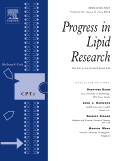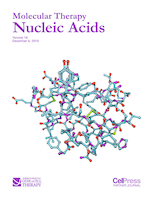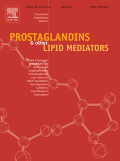
LIPIDS
Scope & Guideline
Pioneering research in lipid biochemistry and beyond.
Introduction
Aims and Scopes
- Biological Roles of Lipids:
Research on the physiological and pathological roles of various lipids, including their involvement in cell membrane structure, signaling pathways, and metabolic processes. - Lipid-Membrane Interactions:
Investigations into how lipids interact with biological membranes, including studies on lipid bilayer dynamics, membrane fluidity, and the effects of different lipid compositions. - Lipidomics and Metabolism:
Comprehensive analyses of lipid profiles in biological samples, exploring lipid metabolism and its implications in health and disease, particularly in metabolic disorders and cancer. - Therapeutic Applications of Lipids:
Development and evaluation of lipid-based drug delivery systems, including liposomes and nanoparticles, aimed at enhancing drug solubility, stability, and bioavailability. - Innovative Analytical Techniques:
Utilization of advanced analytical methods such as NMR, mass spectrometry, and synchrotron-based techniques to characterize lipids and their interactions. - Synthetic and Natural Lipid Derivatives:
Synthesis and characterization of novel lipid compounds, including bioactive lipids and their potential applications in medicine and biotechnology.
Trending and Emerging
- Nanotechnology in Lipid Delivery Systems:
There is a growing emphasis on the development of lipid-based nanocarriers for drug delivery, highlighting innovative formulations that enhance therapeutic efficacy and targeting. - Lipid-Mediated Signaling Pathways:
Research exploring the roles of lipids in cellular signaling, particularly in the context of diseases such as cancer and cardiovascular conditions, has become increasingly prominent. - Lipidomic Profiling and Precision Medicine:
The integration of lipidomics into precision medicine is gaining attention, with studies focusing on lipid biomarkers for disease diagnosis and treatment response. - Interdisciplinary Approaches to Lipid Research:
Emerging interdisciplinary collaborations are evident, combining lipid science with fields such as nanotechnology, pharmacology, and molecular biology to tackle complex biological questions. - Sphingolipid Research:
An increase in studies focusing on sphingolipids and their diverse roles in cell signaling and disease mechanisms, particularly in neurodegenerative and metabolic disorders.
Declining or Waning
- Traditional Lipid Extraction Methods:
Research focused on conventional lipid extraction techniques has decreased, likely due to the emergence of more efficient and innovative methods that yield higher purity and better characterization of lipid samples. - Static Membrane Studies:
Studies involving static models of membrane interactions have waned, as researchers increasingly adopt dynamic and in vivo models to better mimic physiological conditions. - Basic Lipid Structure Studies:
There is a noticeable reduction in publications centered solely around the basic structural characterization of lipids, as the field moves towards understanding functional and interactive aspects of lipids. - Lipid Studies in Non-Biological Contexts:
Research exploring the properties of lipids in non-biological or synthetic contexts is less prevalent, possibly due to a shift towards applications with direct biological relevance.
Similar Journals

PROGRESS IN LIPID RESEARCH
Innovating Insights into Lipid BiologyProgress in Lipid Research, published by Pergamon-Elsevier Science Ltd, is a leading scientific journal dedicated to advancing the understanding of lipid biology and its implications for human health. With an impressive impact factor, it ranks in the Q1 quartile in both Biochemistry and Cell Biology as of 2023, reflecting its vital role in disseminating high-quality research. Covering a wide scope of topics from lipid metabolism to cell signaling pathways, the journal serves as a key resource for researchers, professionals, and students alike, striving to elucidate the complex functions of lipids in various biological systems. With publication converging since 1978 and extending to 2024, Progress in Lipid Research continues to provide innovative insights and foster collaboration within the scientific community, solidifying its reputation as an essential platform for lipid research.

CURRENT OPINION IN LIPIDOLOGY
Elevating understanding in lipid metabolism.Current Opinion in Lipidology is a premier journal published by Lippincott Williams & Wilkins, offering critical insights into the ever-evolving landscape of lipid research. With an impressive convergence spanning from 1990 to 2024, this journal serves as an essential platform for researchers, clinicians, and professionals dedicated to the study of lipids in relation to cardiovascular health, endocrinology, and metabolism. The journal currently holds a distinguished Q1 ranking in Cardiology and Cardiovascular Medicine, Endocrinology, Diabetes and Metabolism, and Nutrition and Dietetics, showcasing its significant impact in these fields. Additionally, it ranks in the Q2 quartile for Cell Biology and Molecular Biology, underlining its comprehensive approach to lipidology. Though not open access, the content is rich with cutting-edge reviews, clinical studies, and expert opinions that aim to advance knowledge and practice in lipid metabolism, making it a valuable resource for anyone seeking to stay abreast of the latest developments in lipid research.

JOURNAL OF BIOENERGETICS AND BIOMEMBRANES
Illuminating the Pathways of Cellular EnergyJOURNAL OF BIOENERGETICS AND BIOMEMBRANES, published by SPRINGER/PLENUM PUBLISHERS, is a leading journal dedicated to the study of bioenergetics and biomembranes, covering essential topics such as cellular energy transformation and membrane dynamics. Since its inception in 1976, the journal has developed a robust reputation within the scientific community, currently holding a Q3 ranking in Cell Biology and a Q2 ranking in Physiology for 2023. Boasting a prestigious Scopus Rank in both Biochemistry and Physiology, it serves as a crucial platform for disseminating pioneering research findings. With its commitment to quality and innovation, the journal plays a significant role in advancing our understanding of the fundamental processes that underlie life at the cellular level. Although it does not offer open access options, the journal remains accessible through universities and research institutions, ensuring that vital research is widely shared among scholars, professionals, and students alike. The JOURNAL OF BIOENERGETICS AND BIOMEMBRANES is essential for anyone seeking to contribute to or stay informed about developments in this dynamic field.

Molecular Therapy Nucleic Acids
Catalyzing scientific excellence in molecular medicine.Molecular Therapy Nucleic Acids is a premier open-access journal published by CELL PRESS, dedicated to advancing the field of molecular medicine through the innovative application of nucleic acid-based therapies. Since its inception in 2012, this journal has become an essential resource for researchers and professionals in drug discovery and molecular medicine, reflected in its status as a Q1 journal in both categories for 2023. With a notable impact factor and high rankings in Scopus, including #8 out of 157 in Drug Discovery and #16 out of 178 in Molecular Medicine, it serves to disseminate groundbreaking research and foster collaborations among scientists worldwide. The journal's comprehensive scope encompasses a wide variety of topics, including gene therapy, RNA interference, and CRISPR technology, ensuring that it remains at the forefront of scientific excellence. With open access availability, Molecular Therapy Nucleic Acids actively promotes the widespread dissemination of knowledge, making its crucial insights accessible to students, researchers, and industry professionals alike.

PPAR Research
Connecting Researchers with PPAR InsightsPPAR Research, an esteemed journal published by HINDAWI LTD, specializes in the rapidly evolving fields of drug discovery and pharmacology, contributing significantly to the body of research surrounding peroxisome proliferator-activated receptors (PPARs) and their roles in various biochemical processes. With an open access policy implemented since 2006, the journal ensures that its high-quality content is readily available, promoting widespread dissemination of knowledge. Currently ranked in the Q2 category for both Drug Discovery and Medical Pharmacology, it boasts a respectable position within the scientific community, evidenced by its Scopus rankings. PPAR Research serves as an essential resource for researchers, professionals, and students looking to advance their understanding of PPAR biology and its implications in therapeutic development. The journal's commitment to excellence and accessibility makes it a key player in supporting innovative research and critical discussions in the life sciences.

JOURNAL OF THE AMERICAN OIL CHEMISTS SOCIETY
Innovating Solutions for a Greener FutureJOURNAL OF THE AMERICAN OIL CHEMISTS SOCIETY, published by WILEY, is a premier academic journal that has been at the forefront of research in the fields of chemical engineering and organic chemistry since its inception in 1947. With an ISSN of 0003-021X and an E-ISSN of 1558-9331, this journal serves as an invaluable resource for researchers and professionals interested in the latest advancements and methodologies in oil chemistry and related disciplines. The journal holds impressive rankings, placing in the Q2 category for Chemical Engineering and Q3 for Organic Chemistry, reflecting its influential position in the academic community as evidenced by its Scopus rankings. While it follows a subscription model, the journal remains committed to disseminating quality research, aiming to enhance understanding and application within the chemical science sector. Researchers, professionals, and students engaged in oil chemistry and engineering will find JOURNAL OF THE AMERICAN OIL CHEMISTS SOCIETY crucial for staying abreast of developments that shape this dynamic field, as it continues to publish cutting-edge research through to 2024 and beyond.

International Journal of Pharmaceutics-X
Catalyzing collaboration in cutting-edge pharmaceutical research.International Journal of Pharmaceutics-X is a premier open access journal published by Elsevier, dedicated to advancing knowledge and research in the field of pharmaceutical sciences. Launched in 2019, this journal has quickly ascended to the Q1 category in the 2023 Category Quartiles, reflecting its high impact and the quality of research it promotes. With a current Scopus ranking of #49 out of 183 in the Pharmacology, Toxicology and Pharmaceutics category, this journal occupies the 73rd percentile, showcasing its significant influence within the scholarly community. Emphasizing innovative research and novel applications, the International Journal of Pharmaceutics-X offers a platform for researchers, professionals, and students to disseminate their findings, making crucial contributions to the global pharmaceutical landscape. The journal is based in the Netherlands, presenting a vibrant hub for scientific discourse and collaboration in a rapidly evolving field.

BIOCHIMICA ET BIOPHYSICA ACTA-MOLECULAR AND CELL BIOLOGY OF LIPIDS
Fostering Knowledge in Lipid-Related ResearchBIOCHIMICA ET BIOPHYSICA ACTA-MOLECULAR AND CELL BIOLOGY OF LIPIDS, published by Elsevier, is a leading academic journal that focuses on advancing the field of lipid biology. With an ISSN of 1388-1981 and an E-ISSN of 1879-2618, this journal has established itself as an essential resource for researchers, professionals, and students interested in cell and molecular biology, particularly regarding lipid interactions and functions. The journal boasts an impressive impact factor, standing in the top quartiles of its categories—Q1 in Molecular Biology and Q2 in Cell Biology. As part of the vibrant academic landscape of the Netherlands, it supports both traditional and open access publication models, ensuring that vital research is accessible to a global audience. The converged years from 1998 to 2025 mark its sustained commitment to quality and relevance in the fast-evolving field of lipid research. With a strong ranking in Scopus and a percentile in the 80th range in both Molecular Biology and Cell Biology, this journal continues to be a pivotal platform for scholarly communication and innovation in lipid-related research.

PROSTAGLANDINS & OTHER LIPID MEDIATORS
Fostering Collaboration in Lipid ResearchPROSTAGLANDINS & OTHER LIPID MEDIATORS, published by Elsevier Science Inc, is a leading journal dedicated to the advancements in the field of lipid mediators, with a specific focus on prostaglandins and other bioactive lipids. This journal, indexed under ISSN 1098-8823 and E-ISSN 2212-196X, serves as a crucial platform for researchers and professionals to disseminate significant findings that span multiple disciplines, including Biochemistry, Cell Biology, Pharmacology, and Physiology. In the 2023 category quartiles, it has achieved commendable positions such as Q2 in Biochemistry and Q2 in Physiology, underscoring its importance and influence in these domains. Although it is not an open-access journal, it provides robust access options, enhancing the visibility of vital research. With its establishment in 1996, the journal continues its commitment to fostering innovative research until 2024, making it an essential resource for those involved in the dynamic realms of lipid biology and medical research.

BIOCHEMICAL JOURNAL
Advancing the Frontiers of Biochemical ResearchBIOCHEMICAL JOURNAL, published by Portland Press Ltd, stands as a leading publication in the fields of Biochemistry, Cell Biology, and Molecular Biology, reflecting a commitment to advancing scientific knowledge since its inception in 1945. With a distinguished Q1 ranking across these categories and impressive Scopus rankings, the journal serves as an invaluable resource for researchers, professionals, and students alike, facilitating critical discoveries and innovative research practices. Although not currently offering open access, the journal provides a platform for high-quality peer-reviewed articles, ensuring rigorous standards in the dissemination of biochemical research. Spanning over seven decades and continuing through to 2024, the BIOCHEMICAL JOURNAL fosters an environment where cutting-edge biochemical research thrives, supporting the global scientific community's efforts to address complex biological questions and enhance our understanding of fundamental cellular processes.